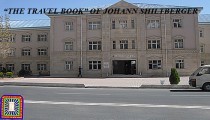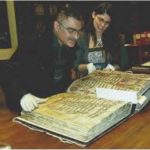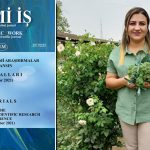“The Travel Book” by Johann Schiltberger as the source on history and geography of the Nakhchivan region of Azerbaijan

One of the sources giving interesting information on historical geography of the Nakhchivan region in the Middle Ages is “Reisebuch” or “The Travel Book” by German military man and traveler Johann Schiltberger, devoted to his travel through Europe, Asia and Africa from 1394 to 1427.
J.Schiltberger, who visited many countries of Europe, Asia and Africa – Hungary, Bulgaria, Wallachia, Moldavia, the Ukraine, Anatolia, Egypt, Palestine, Jordan, Iran, Azerbaijan, Georgia, Dagestan, Circassian, the Crimea and Central Asia, in this book gives also information about Azerbaijani cities of Tabriz, Maku, Maragha, Nakhchivan, Alinjagala, Astara, Shirvan, (Lahyj, Shamakhy and Shabran), Shaki and Darband. These data are in the 33rd section entitled “The countries where silk is gathered, Persia and other kingdoms”.
In the article it is told about the cities, fortresses and settlements of Nakhchivan. There are also cleared up some errors made during translation and interpretation of the book. Location of the cities of Nachson, Maragara, Gelat, Kirna, Gilan, Ress, Strawba, Aluitze in the territory of Nakhchivan is proved through solid arguments.
The interesting data given in the book alleging that Nakhchivan is the Prophet Noah’s homeland are also clarified in the article.
Keywords: Nakhchivan, Kirna, Gilan, Ress, Astabad, Noah, traveler, historical geography, city.
The researches concerning the fact that Nakhchivan is the land where the Prophet Noah firstly appeared after the deluge, expanding the recent years, are gradually putting forward more valid proofs. The historians carrying out the researches in this direction ground upon many sources and background materials, on the works of travelers, military men and artists, on the photos, on the legends and tales widespread among people. While researching the sources relating history and geography of Nakchivan in the Middle Ages we face one more source informing about relation of Nakhchivan territory with the Prophet Noah. This source of the Middle Ages is “Reisebuch” or “The Travel Book” by Johann Schiltberger, who lived in the end of the XIV – in the beginning of the XV century, devoted to his travel through Europe, Asia and Africa from 1394 to 1427. We should note that this travel writings were translated from the old German language to the Russian language in 1867 by professor of Novorussia (Odessa) University, Doctor of Historical Sciences F.K.Brown (1804-1880) entitled as “Johann Schiltberger’s Travel Writings” (4). Just after Brown’s translation “The Travel Book” was published in English and in German. And in Azerbaijan this translation work was published in 1984 in the Russian language by edition of Academician Ziya Bunyadov. The book is known in Turkey by name “Between Turks and Tatars (1394-1427)”.
But who is Johann Schiltberger? He was born in 1380 of a noble family at Hollern near Lohhof halfway between Munich and Freising. In 1394 he started fighting under Sigismund, King of Hungary, who was going to fight with Ottoman Empire. At the Battle of Nicopolis on September 28, 1396, he was wounded and taken prisoner by Turks. Afterwards Sultan Bayezid I took him into his service as a runner in his army, and he held that position up to 1402. Schiltberger accompanied Ottoman troops to certain parts of Anatolia and to Egypt. After the Battle of Ankara Schiltberger passed into the service of Emir Timur, and traveled through Central Asia countries following Timurs troop. After Emir Timur’s death he served to Shahrukh, Miranshah and Abubakr. After visiting a lot of countries he went to Istanbul in 1427, and staying there for a time he returned to his homeland – Bavaria again.
During 30 years of captivity Johann Schiltberger toured many countries of Europe, Asia and Africa – Hungary, Bulgaria, Wallachia, Moldavia, the Ukraine, Anatolia, Egypt, Palestine, Jordan, Iran, Azerbaijan, Georgia, Dagestan, Circassian, the Crimea and Central Asia together with those who subjected him. Though Schiltberger’s “The Travel Book” does not attract serious information about political life of these countries at that period, the work is significant for study of the matters relating to historical geography. We should note that the military man from Bavaria – Johann Schiltberger visited also Tabriz, Maku, Maragha, Nakhchivan, Alinjagala, Astara, Shirvan (Lahij, Shamakhi and Shabran), Shaki and Darband cities of Azerbaijan. When Teymur’s army conquering Bayazid, and passing through Asia Minor, Georgia and Abkhazia, stroke a camp in Garabagh, Schiltberger also was in that camp, and then passing the Araz river together with the army, went to Central Asia.
In the 33th section of “The Travel Book” entitled as “The countries where silk is gathered, Persia and Other Kingdoms” the German author gives information about the feudal states and cities in Azerbaijan. After telling about Tabriz, Sultaniyya and Rey, J.Schiltberger writes: “Another city is Nakhchivan, which is surrounded with the mountains, where Noah’s ark stayed. The lands around this city are fruitful” (5, p. 44).
We should note that these information are repeated both in the full English variant prepared by J.Buchan Telfer and published in London taking as a basis the translation by professor Carl Friedrich Neumann in 1859, that we got from the library of Berkley University of California, and in the Russian variant published in 1984 in Azerbaijan with edition of the academician Ziya Bunyadov on the basis of Brown’s translation. But when getting acquainted with full English text of the book published with the title “Captivity and Travels of Johann Schiltberger from Bavaria (Europe, Asia and Africa. 1396-1427)”, which we got from Berkley University, it becomes clear that in the Russian translation some matters and the names of the cities were distorted.
In Russian variant the text continues this way: “Next follow the country of three cities: Maragha, Hilat and Karni. Besides, there is a city situated on mountains and called Magu.
…There is one more rich country here, it is called Gilan, where rice and cotton are gathered. Its dwellers sew footwear from leather. The next is the city situated on a big valley called Rasht. There is also Astrabad which is situated on favorable position too.
There is also the city called Antiokh, which has red pinion walls” (4).
It looks a bit strange that the author speaking about Nakchivan city suddenly proceeds to information about the cities on the South shore of the Caspian Sea, and then again gives information about the city of Antiokh situated to the south of the Eastern Anatolia – on the shore of the Mediterranean Sea. It is a question, why the cities are specified not by territorial sequence, but in mixed order. That is why we appeal to the book which we got from the library of California University, and reading the analogous part of the text we find answer to our question: “There is another city called Nachson here; It is situated near the mountains where Noah’s ark had stayed, and this country has fruitful territories. In it are also three cities, one called Maragara (Maragha), the other Gelat (Hilat) and the third Kirna. All three cities have fruitful ground. There is another city here called Meya (Maku), which is also situated on the mountains. ….There is also the region called Gilan, where cotton and rice are cultivated and its population sews footwear from leather. There is also a big city called Ress, where silk kerchiefs (head-dresses) are knitted. There is also a city called Strawba.
Another city is Antiokh, which has red pinion walls” (5, p. 44).
As explanations section of this edition is also based on interpretations of Brown, the professor of Novorussia University, Kirna is presented as /Gərni/, Ress – as /Rəʃt/, Strawba – as /Astrabad/ (5, s. 156-160).
When analyzing the text attentively it becomes clear that Shilterberger does not talk about the cities of different countries in mixed order, but talks about Nakhchivan and its surrounding territories. Nachson, which is talked in the text about, is Nakhchivan as all authors agree unanimously. Another traveler Klavixo giving information about this period informed that he passed through a city called Naujua two days before reaching Calmarain (Surmali situated in the territory of Ighdir region of Turkish Republic). Unanimous opinion of researchers is that: the city called “Nachson” by Schiltberger, and called “Naujua” by Klavixo is definitely Nakhchivan.
The phrase “It is situated near the mountains where Noah’s ark had stayed” in the text (5, p. 44) is the fact which reaffirms that Nakhchivan is Noah’s land. Anyway it is impossible to allege that the traveler speaks of Aghri mountains. Because the author uses the phrase “Agourou” (Aghri) in another place of the text. If Schiltberger implied here Aghri mountains he would not pass through not mentioning it. Therefore, German military man and traveler did not know names of present Hachadagh or Kamki mountains that he sow, and called them simply “the mountains where Noah’s ark stayed”.
“In it are also three cities, one called Maragara, the other Gelat and the third Kirna”. In Russian translation of the work this sentence was translated with distortion. Thus, in English text the phrase “in” in the part “In it are also three cities…” was intentionally translated as “next”. Let’s draw attention: “In it are also three cities, one called Maragara, the other Gelat and the third Kirna” (5, p. 44). – «Затем идет страна с тремя городами: Марага, Хилат и Карни» (Next follow a country with three cities: Maragara, Gelat and Karni) (4). Therefore, from correct translation of this sentence it becomes clear that these three cities were not separate feudal state, but were Nakchivan territory.
Revelation of such a fact about the first mentioned city – Maragha (Maragara) may play a role of some proof in confirmation of existing assumptions relating to that the children of Nasiraddin Tusi, who was Hulaku khan’s vizier, lived in Ordubad territory, and Nasiraddin Tusi was from Ordubad by origin.
Schiltberger’s information also serves as a foundation for saying that in that period Hilat (Ahlat) also was under governance of Azerbaijan governors. And this disproves Armenians’ claim on this ancient Turkish land. We should note that Hamdullah Gazvini who displayed the boundaries of Azerbaijan country in the VIII section of “Nuzhat all Gulub” giving dimensions of Azerbaijan lands with farsakh (12 thousand steps – appr. 6-8 km) indicated the distance from Baku to Khalkhal, and from Bajravan to Sipan (Subhan) mountains (3, p. 37). We should note for information that Suphan mountains situated in the territory of present Turkey are located on the North of the Van lake. Therefore, as we noted above, in the period of Mongols the lands not only by Hilat, but also the lands by Van were Turkish lands and related to Azerbaijan.
It is known that the Kirna toponym in Nakhchivan territory remains up to the present time, a necropolis exists in Kirna territory, and there have been found material-cultural patterns applying to city culture (2, p. 219-220). We should take into account that the German author spoke of it not as a fortress, but as a city. That is why it is not correct when translators and following researchers reduce the word written in the original text as “Kirna” to the form of “Garni”, and identify it with a fortress near Yerevan.
As well as it is wrong to identify the city of Gilan, which is talked about, with Gilan situated on the shore of the Caspian Sea, and Ress with Rasht. Johann Schiltberger talks about Kiran (Destroyrd Gilan – E.K.) remnants of which are remaining in Nakhchivan territory up to the present time, and about the city called “Ress” situated on the shore of the Araz river, talked about in the Middle Ages sources as “ar-Rass”. We should note that, in another Arabian source dated from the XII century – “Kitab al-Ansab” (“The Book of Nicknames”) Abu Saad Abdulkarim ibn Mahammad as-Samani spoke of the nickname of “Ar-Raas” and wrote that sheikh having this nickname lives in Nakhchivan (Nashavan) (1, p. 112). And the city situated in a good country and called Strawba is not Astrabad situated in the present Iran territory, but is the Middle Age city Astabad situated 12 kilometers to the south-east of Nakhchivan city. We should note that this city which’s remnants remain near Babak settlement was one of the main centers of hurufism in the Middle Ages, and the place where Fazlullah Naimi Astabadi was born. During construction of Araz Water Junction in 1967-1971 the ruins of the city was left under the water (2, s. 28).
In “The Travel Book” by Johann Schiltberger another settlement area mentioned in relation with Nakhchivan territory is Alinja. German author speaking of Alinja as “Aluitze” describes it not just as defensive fortress, but as a city, and writes that Teymur could occupy the fortress only after keeping it under blockade during 16 years (5, p. 44).
Consequently, “The Travel Book” by Johann Schiltberger, which we may present as one of the most ancient written sources confirming that Nakhchivan is Noah’s native land, is a reach source for historical geography of Azerbaijan, as well as Nakhchivan in the Middle Ages.
BIBLIOGRAPHY
1. Əliyeva N. Əs-Səmaninin “Kitab əl-Ənsab” əsəri Azərbaycanın mədəniyyət tarixinə dair mənbə kimi. Bakı: Şərq-Qərb, 2010, 224 s.
2. Naxçıvan abidələri ensiklopediyası. Naxçıvan, 2008, 519 s.
3. ХамдаллахКазвини. Нузхат ал-Кулуб (Материалы по Азербайджану). Баку: Элм, 1983, 65 c.
4. www.vostlit.info. Шильтбергер И. Путешествие по Европе, Азии и Африке с 1394 года по 1427 год / Перевод со старонемецкого Ф.К.Бруна. Издание, редакция и примечания академика АН Азерб. З.М.Буниятова. Баку:Элм, 1984.
5. The Bondage and travels Johann Schiltberger, a native of Bavaria, in Europe, Asia and Africa 1396-1427. London, 263 p.
(presented by Academician İ.M.Hajiyev)
ELNUR KALBİZADEH
Nakhchivan Department of
Azerbaijan Academy of Sciences
E-mail: caspianman@mail.ru
N1,2014, p.70 – 76
As the source on history and geography of the Nakhchivan region of Azerbaijan
The texts were republished in English by “AqRa” PASAS by financial support of the Council of State Support to Non-State Organizations under the President of the Republic of Azerbaijan.
Translated by Amiraslanova Kamala Ahad gizi







